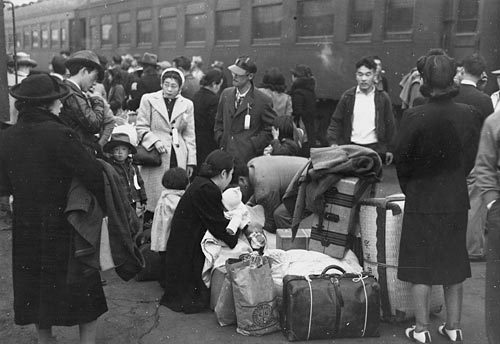Japanese Internment at Topaz

The histories told of World War II are often told in tones of patriotism, justice, and progress. However, popularized narratives often leave out some of the more complicated and messy events of the time. The history of Japanese Internment at Topaz, Utah is one such story.
The broad narratives of American involvement in World War II include often feature the United States as the hero of the Allied powers, men old and young fighting in Pacific and European theaters of war, and the American home-front experiencing an increase in manufacturing, women in the work force, and rations to support the cause of war. America's involvement led to the Axis powers fall and saved the world from Nazis, fascists, villainous Adolf Hitler, and expanding militarized Japanese empire. This simplified plot, however, leaves out much. What great stories have we missed in our past in the name of perpetuating an overwhelmingly positive American narrative? What lessons about humanity have been sacrificed?
Topaz, Utah is the site of one such lesson. It is here that 11,212 Japanese-Americans were interned over the course of World War II, with a peak population between 8,100 and 8,300. Executive Order 9066 was signed into action by President Franklin D. Roosevelt on February 19, 1942, ten weeks after the Pearl Harbor attack, and was supported by Congress through Public Law 503 and deemed constitutional by the Supreme Court in the context of war. Such actions sanctioned the voluntary evacuation, then the forced removal, of West Coast residents of Japanese ancestry by the U.S. Army to assembly centers and isolated relocation centers—regardless of citizenship. This decision followed a filing of the Munson report, an investigation of Japanese Americans living on the West Coast, on November 7, 1941 which included such conclusions as “[when] interview after interview piled up…the story was all the same. There was no Japanese ‘problem’ on the Coast. There will be no armed uprising of the Japanese.”
Moving to internment camps required the sacrifice of careers, properties, and constitutionally-protected rights. Those in the camps made efforts to return to some sense of normalcy; children attended school, adults were employed by the War Relocation Authorities inside camps, and some internees were even able to leave the camp for school or work. At Topaz specifically, the headquarters of the Buddhist Church of America was established, the Boy Scout bugle corps met regularly, and baseball leagues developed and grew to occupy two of the forty-two camp blocks. Not to acknowledge the irony of a love for baseball within the camps, a true American sport, in the midst of a whole-scale questioning of American-ness would be a mistake.
Most historians point to a trifecta of factors allowing the internment of an entire population in “the land of the free”—namely, racial prejudices, wartime hysteria, and ineffective government leadership. Using the sources below, reflect on the federal actions taken against Japanese-Americans. Was internment necessary? How does an event like this can uncover our own human nature? Asking such questions is not simply an attempt to poke holes in treasured American histories, but to more fully understand human experience in American history. The history of Japanese Internment at Topaz and elsewhere invites us to build empathy and understand with past and present human experience.
Images







